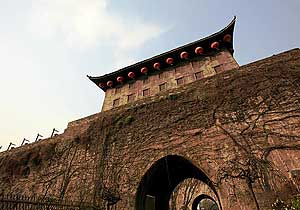Zhonghua Gate

Zhonghua Gate (literally Gate of China), based on the former site of the south gate of the capital city of the Southern Tang Dynasty (937-975), was built by the first Ming Dynasty emperor--Zhu Yuanzhang (1368-1644). It was renamed from previous Jubao Gate (Chinese: 聚宝门/聚寶門; pinyin: Jùbăomén; literally "Gathering Treasure Gate") in 1931 after Chiang Kai-shek made Nanjing as the capital of Republic of China government to mark his victory and signify its status as "gate of the nation".
As the biggest among the 13 castle gate remnants, the Zhonghua Gate, covering over 15,000 square meter, was built with the strip stone bricks stamped with the names or other specific info of the brick-maker and supervisors that monitored the brick-making process so as to ascertain the blame once bricks failed the quality control check. Many of the ancient inscriptions in the official characters or the craftsmen rough writing are still visible on brick sides. Such kind of building strictness can explain why this gate can still stand through the ages.
The heavily-fortified gate has four rows of arched gates and 27 scattered vaults that could hold as many as over 3,000 soldiers. Each arched gate was stalled with portcullis and wooden door that slammed shut to trap the enemy invaders that would be ambushed by the hidden soldiers in vaults. The portcullis and door have gone and only the trough and marks can be seen while some of these vaults have been turned to local souvenir shops. Inside the gate there are displays and information detailing the history of the walls. The wide steep horse ramps on the sides of the gate served as the shortcuts for transferring the military material or officers up to the castle top floor. Up the wall, wider view of the gates with the city can be seen spreading out beyond. Painted warrior statues along the ramps, banners and red lantern can be seen contrasting with the bleak ancient wall.